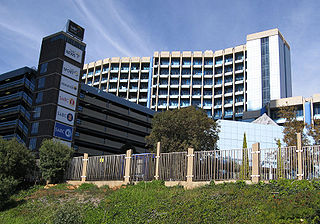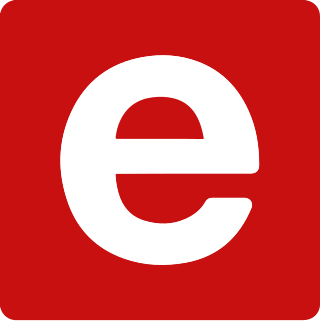Related Research Articles
Integrated Services Digital Broadcasting is a Japanese broadcasting standard for digital television (DTV) and digital radio.

Television in South Africa was introduced in 1976. The country is notable for the late introduction of widespread television broadcasting.

The South African Broadcasting Corporation (SABC) is the public broadcaster in South Africa, and provides 19 radio stations (AM/FM) as well as six television broadcasts to the general public. It is one of the largest of South Africa's state-owned enterprises.

SABC 3, also branded as S3, is a South African free-to-air television channel owned by the South African Broadcasting Corporation (SABC). Since March 2024, it carries programming in English and Afrikaans only.

SABC 2 is a South African free-to-air television channel owned by the South African Broadcasting Corporation (SABC).
Digital terrestrial television is a technology for terrestrial television, in which television stations broadcast television content in a digital format. Digital terrestrial television is a major technological advancement over analog television, and has largely replaced analog television broadcasting, which was previously in common use since the middle of the 20th century.
Free-to-air (FTA) services are television (TV) and radio services broadcast in unencrypted form, allowing any person with the appropriate receiving equipment to receive the signal and view or listen to the content without requiring a subscription, other ongoing cost, or one-off fee. In the traditional sense, this is carried on terrestrial radio signals and received with an antenna.
Digital terrestrial television in the United Kingdom encompasses over 100 television, radio and interactive services broadcast via the United Kingdom's terrestrial television network and receivable with a standard television set. The majority of digital terrestrial television (DTT) services, including the five former analogue channels, are broadcast free-to-air, and a further selection of encrypted pay TV services are also available. Freeview is the only DTT service since Top Up TV closed in 2013.

e.tv is the first and only privately owned free-to-air television station in South Africa. It is the fifth terrestrial television channel in the country, following three channels that are operated by the state-owned South African Broadcasting Corporation and the privately owned subscription-funded M-Net. In 1997, the e.tv channel bought the broadcasting rights to broadcast English Premier League (EPL) matches and, later on, they also bought the rights to broadcast UEFA Champions League matches.
A television station is a set of equipment managed by a business, organisation or other entity such as an amateur television (ATV) operator, that transmits video content and audio content via radio waves directly from a transmitter on the earth's surface to any number of tuned receivers simultaneously.
KGTF is a PBS member television station licensed to Hagåtña, Guam, serving the U.S. territory. The station is owned by the Guam Educational Telecommunications Corporation, an agency of the territorial government. KGTF's studios are located in Mangilao, adjacent to Guam Community College, and its transmitter is located on Mount Barrigada in Barrigada. KGTF currently operates from 6 a.m. to midnight seven days a week.
DZRJ-DTV is a commercial independent digital-only television station based in Makati City, Metro Manila, Philippines. The station is the flagship TV property of Rajah Broadcasting Network, Inc., a broadcast company owned by long-time guitarist/musician Ramon "RJ" Jacinto. The station's broadcast facilities, shared with its AM and FM radio sisters, are located at the Ventures I Bldg., Makati Ave. cor. Gen. Luna St., Makati; DZRJ-DTV's transmitter facility is located at Merano Street, Brgy. San Roque, Antipolo City, Rizal Province
The television industry in Turkey includes high-tech program production, transmission, and coverage. Turkish Radio and Television Corporation is Turkey's largest and most powerful national television station. As of 2022, there are 498 television channels in Turkey, ranking fourth in Europe in terms of the number of television channels. Turkey is the world's fastest-growing television series exporter and has currently overtaken both Mexico and Brazil as the world's second-highest television series exporter after the United States. Turkish television drama has grown since the early 2000s.

The Namibian Broadcasting Corporation (NBC) is the public broadcaster of Namibia. It was established in 1979, under the name South West African Broadcasting Corporation (SWABC).
Digital terrestrial television in Canada is transmitted using the ATSC standard. Because Canada and the U.S. use the same standard and frequencies for channels, people near the Canada–United States border can watch digital television programming from television stations in either country where available. The ATSC standards are also used in Mexico, the Dominican Republic, Suriname, and South Korea.

Cape Town TV is a community television channel that broadcasts in Cape Town, South Africa. It launched in September 2008 with a one-year, "temporary" license and thereafter won another such license in September 2009. It is a non-profit organisation that is licensed as a community broadcaster in terms of South Africa's Electronic Communications Act.
Television is the most popular medium in Russia, with 74% of the population watching national television channels routinely and 59% routinely watching regional channels. There are 6,700 television channels in total. Before going digital television, 3 channels have a nationwide outreach : Channel One, Russia-1 and NTV.

Botswana Television is the national broadcaster in Botswana. Botswana's first national television service started in 2000 following a 1997 government decision. The station delivers thirteen hours of local and international programmes daily on weekdays and 13 hours of programming on weekends.
TVAfrica was a pan-African television network founded in 1998 by former advertising executive Dave Kelly alongside sports broadcaster Berry Lambert. The network relayed up to 80% of its content to private television stations in sub-Saharan Africa and also licensed the broadcast of sporting events to interested broadcasters. At its apex, the channel broadcast to as many as 26 countries, the majority of them English-speaking and French-speaking states. There were separate versions, in English and French.
References
- 1 2 3 4 5 Tshepho Mosime, Sethunya (March 2007). Botswana Television (BTV) Negotiating Control and Cultural Production in a Globalising Context: A Political Economy of Media State Ownership in Africa (PDF) (PhD thesis). University of KwaZulu-Natal. Archived from the original (PDF) on 3 December 2021. Retrieved 23 November 2023.
- ↑ "The State of the Media in Southern Africa 2000: Botswana" (PDF). nyamnjoh.com via Media Institute of Southern Africa. 2001. Archived from the original (PDF) on 8 April 2005. Retrieved 23 November 2023.
- ↑ "GBC geta broadcasting licence", Africa Film & TV Magazine, nº. 35, November 2002-January 2003
- ↑ "GBC Unsure of Future". AllAfrica. 17 October 2003. Archived from the original on 22 October 2003. Retrieved 4 November 2023.
- ↑ "Botswana: GBC TV Ready to Go National". AllAfrica. 18 September 2003. Archived from the original on 10 December 2009. Retrieved 23 November 2023.
- ↑ "Botswana: Giving GBC TV a New Look". AllAfrica. 6 May 2008. Archived from the original on 12 May 2008. Retrieved 23 November 2023.
- ↑ "Botswana: New Era Dawns for GBC-Tv". AllAfrica. 17 July 2008. Archived from the original on 23 November 2023. Retrieved 23 November 2023.
- ↑ "GBC set to relaunch soon". Mmegi. 4 February 2010. Archived from the original on 24 November 2023. Retrieved 23 November 2023.
- ↑ "Channel Profile". eBotswana. 2010. Archived from the original on 28 May 2012. Retrieved 20 September 2024.
- ↑ Sentech's 'pirated' Botswana signal finally off-air, ITWeb Africa, 1 July 2013
